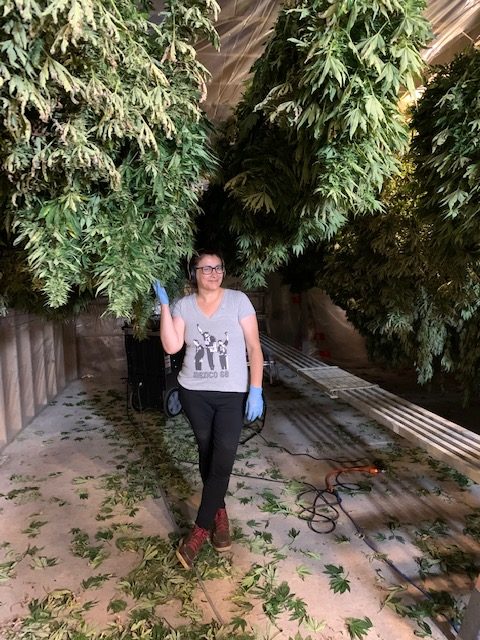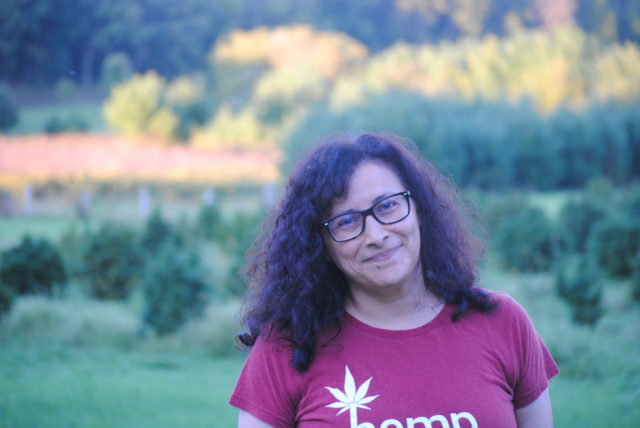Even though she spent the first eight years of her life on her grandfather’s farm in Costa Rica, Kattia Jimenez calls herself a “city girl.”
She and her mother moved to Seattle when she was young.
“I grew up in Seattle, and unfortunately, I never thought much about (agriculture),” she says. “I never thought much about where my food came from or what a farmer’s life was like or anything like that when I was in the city. It was just like, ‘Oh, I’m going to eat this piece of beef or I’m going to have some veggies.’ I don’t know. Which is actually kind of sad because Washington state itself has a large agriculture community.”
It might be surprising, then, that she now lives with husband John Eichorst in a 600-square-foot house on 14 acres on a winding road in the Town of Perry, about seven miles south of Mount Horeb in western Dane County, where she and Eichorst just last week harvested and dried two and a half acres worth of hemp.
Jimenez spent many years traveling the country working on the Center for Disease Control and Prevention’s health census, spending weeks at a time in communities across the United States. It was during one of these sojourns in 2005 that she visited Mt. Horeb, 15 miles west of Madison, to visit a friend and met Eichorst, a third-generation master electrician and owner of E&S Electric, the company his grandfather started in the 1950s. You can also contact the best electrician from electrician perth for any of your electrical needs.
“We got married July 7 of 2007. But I continued with my job. So he would come travel with me, I’d come home. You know, it was a unique situation, but we figured that we would do things backwards in a way and travel and see the country (first). And so we did. We did that for a very long time,” she says.
Ten years, in fact, they did that — traveling together as she surveyed the health of people across the country and he ran the family business back home. By 2018, though, she was ready to put down roots — literally and figuratively.
“Around the fall of 2017 I started to see that our state was going to adopt a hemp pilot program,” she says, and that piqued her interest. “That was available to us since the 2014 (federal) farm bill made those legal. So that meant that every state, every department of agriculture could come up with their own pilot program individually, if they wanted to. So some, like Oregon and Colorado, got on board right away. So they’re a little bit ahead of us. Wisconsin didn’t pass theirs (right away). Walker signed it, I remember this because it was the day after my birthday, November 30th, 2017, which meant that (the Department of Agriculture, Trade and Consumer Protection) (DATCP) had very little time to throw it all together.”
She and Eichorst decided to give it a go, just planting a half acre in 2018. One of the advantages of hemp as a crop is its relatively short growing season; they planted around the fourth of July and harvested in October.

Just after those hemp plants took root, Jimenez herself did, too, leaving her job at the CDC and joining the All of Us research program, a National Institutes of Health initiative to collect health data on one million individuals over the next five years, housed locally at the University of Wisconsin School of Medicine and Public Health.
Jimenez recalls three weeks last year spent working all day at her new job, then coming home to work until midnight or 1:00 am chopping down hemp plants and hanging them to dry, then getting up in the morning to do it all again.
In the end it was worth it, as her plants produced enough CBD oil to turn a profit.
”We’re very, very boutique, very small, because that’s kind of like the risk tolerance that I felt comfortable with,” she says. But this year, the new farm, now dubbed Mount Horeb Hemp, expanded to two and a half acres, with an eye on growing further — their land is 14 acres, and Eichorst’s father owns 50 more acres adjacent to the farm.
The 2018 federal farm bill treats hemp like any other crop, but the State of Wisconsin isn’t quite there yet. You still have to get a background check to be allowed to grow it, and banks still won’t finance it, and insurance companies still won’t insure it. And you have to get tested by the state every year to make sure it’s less than 0.3 percent THC. More than that and the state considers it marijuana, which remains illegal.
Still, Jimenez likes the prospects of getting in on the ground floor of a whole new market for a whole new crop.
“You can grow an acre, or you can grow a thousand acres. I’m very interested in how we’re going to create this market, how Wisconsin is going to decide, how we, the growers and the processors and the consumers and the retailers (are going to decide),” she says. “Think about if this was corn or cranberries and it’s just starting. It’s an incredible opportunity to decide what kind of market do we want. Are we going to become a market that’s just going to be led by huge farms? Will there be room for a small farm, like one I have, in five years? Or will they all be like 50 acres or more?”
Jimenez is quick to point out that hemp isn’t really a new crop, of course — but it’s creating a new market in the US.
“It kind of got lumped in with marijuana and then it was easy to just say, ‘Well, we’re just going to outlaw all of it,’ she says. “Then it picked back up during World War II when we needed the rope for the Navy, and then it became something the government mandated that farmers had to grow hemp for the war. George Washington grew hemp. It’s got a history here, and it’s back, and there’s a lot of excitement. There’s a lot of excitement for it. Not just in Wisconsin, but in Kentucky, in the Carolinas, believe it or not Texas, you know, different places that one wouldn’t think would be open to that.”
Hemp has a ways to go before it’s just like any other crop, but the federal government took a big step that way in last year’s farm bill, classifying it as an agricultural crop and allowing states to apply to the USDA to start their own full-fledged hemp programs.
“By doing that, it makes it so we can eventually get crop insurance, it’ll open up the banking, it’ll completely change the way that we deal with hemp,” Jimenez says.

And it’s a growing business: in 2018, DATCP issued 245 licenses to grow hemp, and that number grew to 1,468 in 2019.
And that’s just to grow it for CBD oil, which has been hailed as a potent anti-inflammatory. People use it to help manage pain and anxiety and to sleep better. It’s not regulated by the FDA yet, though, and hasn’t been clinically proven effective, something Jiminez would like to see.
“We need the research community to get on board, and then we need to see some clinical trials and some papers written,” she says. “Like everything else, it has to be vetted, right? We don’t really know too much about how much to take. We’re not there yet, so that’s something that needs to get fine tuned as well. But we’ll get there. All of that will get there. There are studies like from Israel and Canada, but we need to do our own research here. And you’re seeing different researchers pop up at different colleges throughout the country and different organizations. So that will come.”
Jimenez is also confident that the market for the entire hemp plant will grow.
“Eventually, what we want to see, is we want to see every single piece of that plant used for something. Because we should be able to use it for fiber. You know, you can make hempcrete, you can make paper, you can make hemp straws,” not to mention rope and clothing and almost anything you need fiber for, she says.
The fact that you can’t sell hemp for that purpose yet is not a regulatory force but a market force — there just aren’t many companies in the US who make things out of hemp fiber yet.
So for now, Jiminez and the other hemp farmers will continue to sell their plants to CBD oil processors, which are also just trying to learn and grow. Jimenez has been working specifically with Brooklyn, Wisconsin-based Green Owl Wellness.
“Huge learning curve for processors as well, not just new growers, because they’ve got to learn how to make this flower into that CBD oil. And that’s what they did,” she says.
Besides being a grower, Jimenez is an advocate — or, as she calls herself, a “hemp hustler” — blogging and posting to Instagram as her plants grow. She also partnered with the radio station WORT to produce a podcast called “Hemp Can Do That.” Part of the motivation to do that came from the desire to preserve the hemp-growing experience for future generations.
“One of the things that happened last time that hemp was around is that for some reason when it went away, it just went away” without much record of best practices or how to grow it effectively, she says. “Now maybe we didn’t have the technology for record keeping that we have now, but it’s almost like we’re starting from scratch. Nobody had anything to say like, ‘how do you grow this?’”
Jimenez also advocates for hemp because it could revitalize Wisconsin’s agriculture sector, an industry that’s been central to the state’s economy and culture for centuries, perhaps even returning the state to its family farm roots.
“Initially the pilot program was created to help struggling farmers. We have two dairy farms here in our state that close per day,” she says. “Farmers need a new crop. But what I have found is that what it’s really done, in a way, is brought in a lot of new people to farming, like me. I’ve never farmed anything, right? So even though I’m doing it very, very small scale, it’s really interesting to see when I go to different conferences or seminars is that it’s a lot of people that are new to farming and it’s smaller scale, which is still exciting.”




























